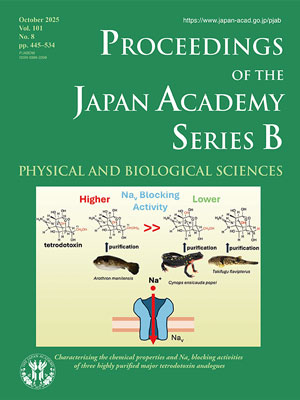Vol. 101 No. 8 (2025)
Table of Contents
Review
-
Development of phytochemical genomics: From decoding metabolome to functional genomics and biotechnology of plant metabolismKazuki SAITOVolume 101 Issue 8 Pages 445-484
Published: October 10, 2025

Original Article
-
Performance comparison of complementary relationship and inverse analysis methods for evapotranspiration estimationToshisuke MARUYAMA, Manabu SEGAWA and Hiroshi TAKIMOTOVolume 101 Issue 8 Pages 485-509
-
Syntheses and biological evaluation of M-COPA analogs derived from pentadienoic Weinreb amideHisazumi TSUTSUI, Daiki USUKURA, Fumiya WATABE, Hiroki OKANO, Ryo HIRATA, Ryunosuke SHIOGAMA, Yamato KANAI, Saki KATO, Yuki ASAHARA, Sayaka CHOGI, Yingjia LU, Haruka HIRAI, Mai KITAMOTO, Miho KOJIMA, Yuuki OBATA, Motoyuki SHIMONAKA, Takatsugu MURATA and Isamu SHIINAVolume 101Issue 8 Pages 510-518
-

-
Chemical properties and biological activities of three highly purified major tetrodotoxin analoguesMari YOTSU-YAMASHITA, Yuta KUDO, Kyoka SATO, Osamu CHIBA, Yuko CHO, Ryuichi WATANABE, Toshiyuki SUZUKI and Keiichi KONOKIVolume 101 Issue 8 Pages 519-533





